Dental Implants Reynoldsburg
A New Standard for Tooth Replacement
If you've lost one or more permanent teeth for any reason, dental implants in Reynoldsburg can help you reclaim good oral health and wellbeing. Implants are superior to other restorative solutions because they actually have a structure that’s similar to that of a natural tooth. As a result, patients with dental implants can look forward to outcomes that are more solid and secure. Dentists have been using dental implants since the 1970s, and today, implants have a 98 percent proven success rate in appropriately chosen cases.
Why Choose Glynn Dental of Reynoldsburg for Dental Implants?
- Experienced & Compassionate Dentist
- Long-Lasting & Incredibly Natural-Looking
- We Accept Insurance & Offer Financing
What are Dental Implants?
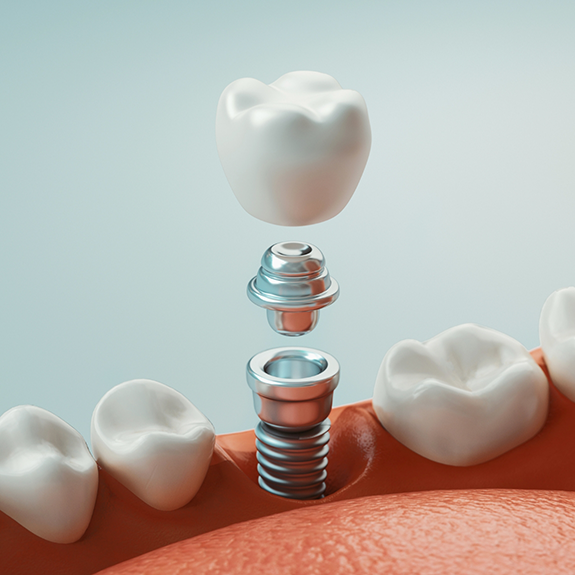
Dental implants are the only tooth replacement option designed to replace both the roots and the crown (or visible portion) of a missing tooth or teeth. A small titanium post is inserted into the jawbone, where it fuses with the surrounding bone tissue. This creates an incredibly reliable and life-like foundation for your new smile. A custom-made crown, bridge or denture is secured to the post with a small connector piece called an abutment. This final restoration is made of high-quality, natural-looking materials, making it practically indistinguishable from the rest of your pearly whites. When you rebuild missing teeth from the roots up, the result is a smile that looks, feels, and functions just like natural.
4-Step Dental Implant Process
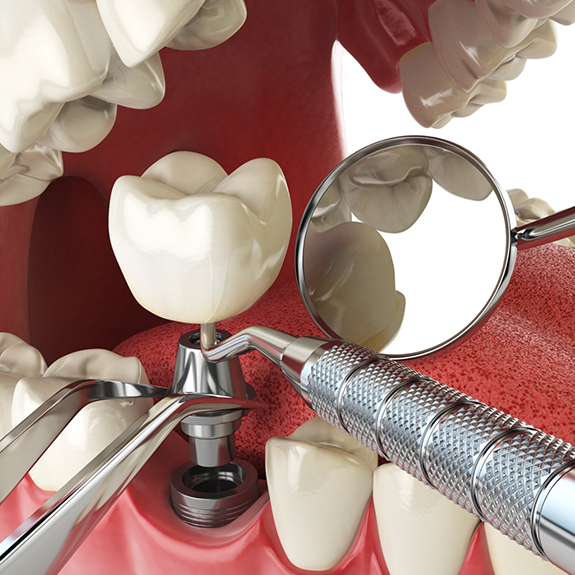
All of the steps of the dental implant process can be completed in-house at Glynn Dental of Reynoldsburg, meaning you won’t have to worry about going to an unfamiliar office across town to see a specialist that you don’t know. The entire process can take several months or even a year, but the smile waiting for you at the end is well worth it. Everyone’s experience with dental implants is a little different, but there are four basic steps that you can expect to be followed.
Initial Dental Implant Consultation

The first step is a dental implant consultation, during which you can expect several questions to be answered – including whether dental implants are right for you in the first place. We’ll check your mouth and your facial structures in order to determine if bone grafting, tooth extractions, or other types of preliminary work are needed. Once we’re confident that your jaw can safely support implants, we can schedule the surgery to have the posts placed in your mouth.
Dental Implant Surgery
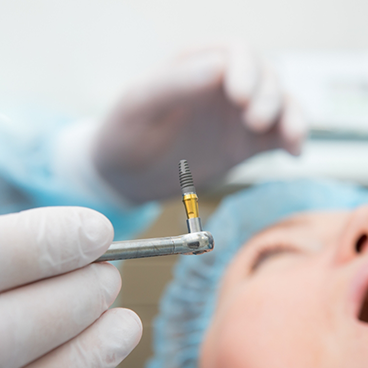
Dental implant surgery is a minimally invasive procedure thanks to modern techniques. Your mouth is numbed before small incisions are made in the gum tissue at strategic points in your mouth. Then the implants are carefully inserted into the jawbone at just the right angles before the gums are stitched shut. A protective cap will be attached to the implant posts; not only does this protect them while your mouth is healing, but it also helps you maintain the overall shape of your gums during recovery.
Dental Implant Osseointegration & Abutment
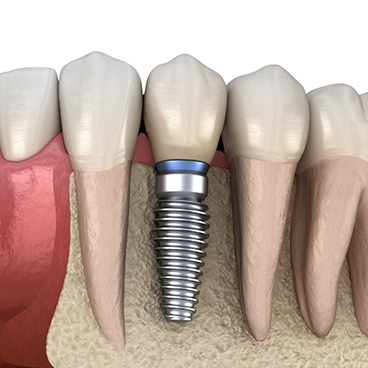
Osseointegration is a natural biological process where the implants fuse with the jawbone. This is one of the most important steps of the whole process; it’s the bond between the posts and the jaw that gives dental implants their strength and stability, allowing you to enjoy all kinds of foods. Osseointegration takes about three to six months, after which we’ll ask you to our office so that an abutment can be attached. An abutment is a connector piece that will secure the final restoration once it’s ready. Installing the abutment will require a second smaller surgery, and as such, some recovery time will be required before we move on to the final step of the procedure.
Delivery of Dental Restoration(s)

After the implants and abutments have all been placed and your mouth has fully recovered, we can take impressions of your mouth in its current state. Then we’ll send the impressions to a dental lab where experienced ceramicists will design the final restoration or restorations. They’ll be made out of a material that can blend in with your natural teeth so that casual observers won’t be able to tell the difference. When they’re ready, we’ll schedule an appointment for you to come back to our office. Some last-minute adjustments may be made before the restorations are attached to the abutments.
Benefits of Dental Implants

Let’s face it—tooth loss is no fun. The biggest problem is looking right back at you in the mirror… the gap in your smile. In addition, you may have trouble eating certain foods and there may even be some words that are difficult for you to pronounce. And don’t forget the consequences to your oral health. All in all, replacing missing teeth is very important. There are several options for this, but the one that is most
Look Younger for Years to Come

To keep your face’s natural outline, you need to make sure your jawbone stays strong and well formed. With a dental implant, Dr. Glynn can replace both the crown and root of a missing tooth. This new root provides your jaw with the stimulation needed to encourage healthy new bone tissue growth, which helps prevent bone deterioration.
Eat & Enjoy

Depending on where on the location of your missing teeth, you may need to cut some foods from your diet, like fresh fruits and vegetables, nuts and red meat. Those are all important to maintaining good health through a nutritious diet. Dental implants in Reynoldsburg will allow you to eat these, and all kinds of foods, as they restore up to 90 percent of your original bite power.
Implants Look & Feel Natural

Because dental implants are built like natural teeth, they are the most lifelike tooth replacements you can have. The implants stand in for your tooth root, while the crown looks and performs like one of your own teeth. You probably won’t even be able to see or feel the difference!
Keep Your Good Oral Health
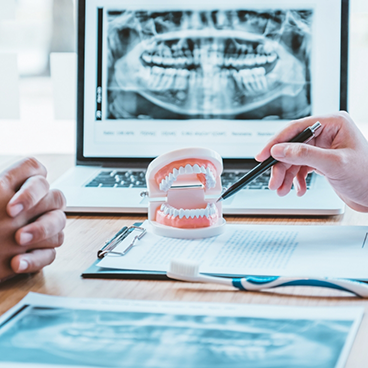
Dental implants are independent tooth replacements, so they do not affect adjacent teeth. A partial, on the other hand, is equipped with clasps that latch on to your other teeth. Dental implants don’t require that kind of support. Furthermore, you’re less likely to suffer additional tooth loss with dental implants that help keep your jawbone strong.
Brush & Floss as Usual

However you take care of your teeth now is how you will take care of your dental implants, too. Just brush your teeth twice a day with fluoride toothpaste and floss at least once a day. Also, schedule regular dental checkups with Dr. Glynn.
A Confidence Booster

Dental implants go a long way toward improving your self-confidence. Even one missing tooth can affect the way you feel in social and professional situations. Replace that tooth with a dental implant and chances are you’ll be back to your old self again in no time.
A Smile That Lasts a Lifetime

Dental implants can cost more than other tooth replacements initially. However, you must consider that with good oral hygiene at home and regular dental checkups, they can last a lifetime. You can’t say that about dentures or a bridge that often require maintenance and eventually will need to be replaced.
Who Dental Implants Can Help

Dental implants can be used in many different situations. They can be just as viable for someone with just one missing tooth as they can be for someone who has lost all of their teeth in one or both jaws. Regardless of the number of teeth that need to be replaced, however, we’ll need to make sure that you’re a candidate for the procedure first. The sooner you schedule a consultation with us, the sooner we can determine whether you’re a dental implant candidate.
Who Is a Good Candidate for Dental Implants?

Before you can get dental implants, you need to be in good oral health; that means having gum disease, cavities, and other issues treated before you continue with the implant process. Additionally, your jaw must have a certain level of bone density in order to support your dental implant post. A lack of bone density can potentially be corrected with a bone grafting procedure.
Our team can discuss the factors that affect your candidacy for dental implants in more detail once you visit our office for a consultation.
Missing One Tooth
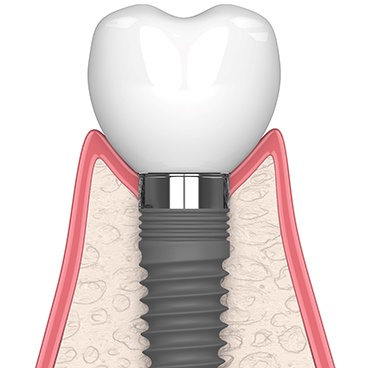
If a tooth is knocked out of your mouth and cannot be salvaged, a single dental implant can be surgically inserted into the resulting gap in your smile. After the implant post has had a chance to fuse with the bone around it, we can take impressions of your mouth in order to design a dental crown that closely matches the appearance of your natural teeth. Once this crown has been anchored to your implant post, it will seamlessly blend in with the other teeth.
Missing Multiple Teeth
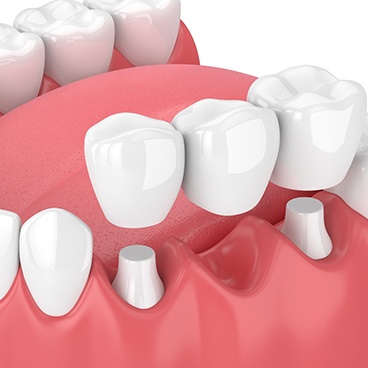
A traditional dental bridge can be used to replace one or more teeth, but a small amount of enamel will have to be removed. Meanwhile, bridges that rely on dental implants for support can be used to fill in the gaps in your grin without making alterations to the teeth that you still have. An implant bridge can be used to replace three or more teeth in a row.
Missing All Teeth
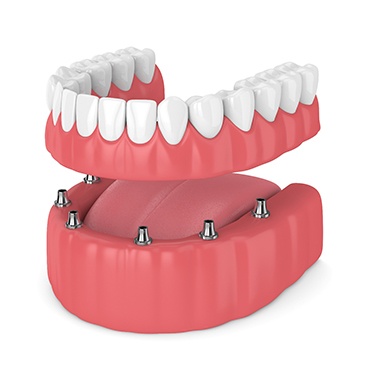
If none of your natural teeth remain in one or both of your jaws, now is the time to consider implant dentures. Like traditional dentures, they can be used to replace many teeth at the same time; however, because they are attached to the jaw by sturdy implant posts, they won’t slip or shift when you’re trying to speak or chew. The exact number of implant posts that your dentures will require depends on your needs; however, typically about 4 to 6 are used.
Learn More About Implant Dentures
Mini Dental Implants
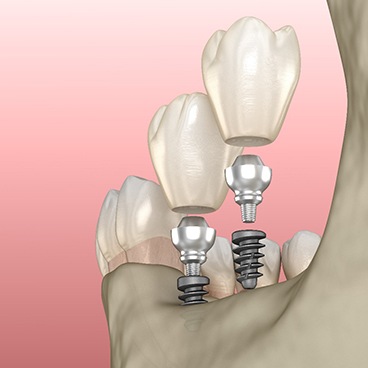
For patients seeking an alternative to traditional implant dentistry, our Reynoldsburg, OH dental office also offers mini dental implants. Imagine visiting our dental office in the morning and having your procedure completed in just a few hours. That’s exactly what you can look forward to with this revolutionary treatment.
The mini dental implant system is specifically for patients who need to replace a full row of teeth but don’t have enough bone to support full-sized implants. This system combines mini dental implants, which act as prosthetic roots when placed in the jaw, with a special retaining fixture that’s fitted into the base of your denture. On the day of your treatment, Dr. Mick will perform a minimally invasive, one-step procedure. Afterward, there won’t be any need for sutures, and you can look forward to a much shorter healing time.
Understanding the Cost of Dental Implants
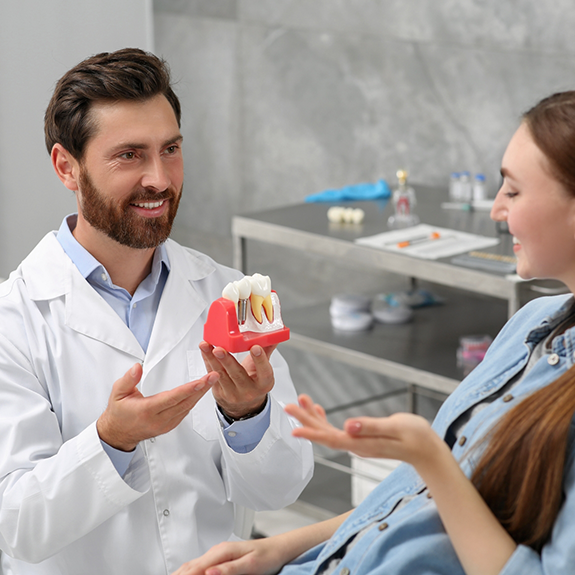
Typically, dental implants cost more than traditional tooth replacement options like dentures or a dental bridge. However, they may easily be the most cost-effective solution over time! While dentures and dental bridges need to be replaced every several years, the one-time cost of dental implants can potentially last you a lifetime! What’s more, there’s no need to buy any special brushes, pastes, or cleaning solutions to keep your new smile healthy and functional.
With dental implants, there is a charge for implant surgery. Then, there is the cost of abutments, the small piece that connects the implant and restoration, and the type of restoration you need—one dental crown, a bridge or a denture. So, while these fees can add to your upfront cost with dental implants, you must consider the long-term value. After all, dental implants can last a lifetime when they are given proper care.
The Longevity of Dental Implants

With proper daily oral hygiene and regularly scheduled dental checkups every six months, your dental implants could easily last for a lifetime. That cannot be said about other tooth replacement options.
Both bridges and dentures will need to be repaired and readjusted to keep them comfortable, and they will inevitably need to be replaced over time. Yes, the upfront cost of a dental implant may be more than other prosthetics. But when you consider that cost over the years of a lifetime, then a dental implant can actually end up costing you less.
The Cost of Preparation

Many dental implant patients require some type of preparatory procedure before receiving implants. For example, some patients need to have teeth extracted or bone and soft tissue grafts in order to ensure that the jawbone and gums are strong enough to support implants.
Charges for these types of procedures vary and depend on the details of each case, such as how many teeth require extraction.
The Cost of a Tooth Restoration
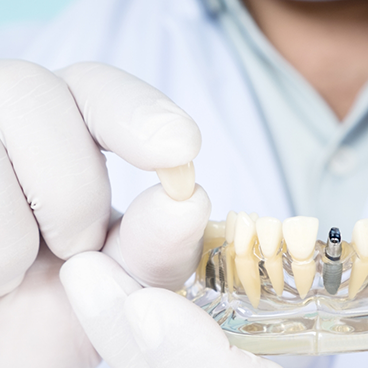
Dental implants are only half of the prosthetic services needed to replace missing teeth. Once the implant is firmly anchored in the bone, then it’s time to attach the portion that everyone sees when you smile. In the case of a single missing tooth, Dr. Glynn will need to place a dental crown over the implant. If you are replacing several teeth with implants, then he may recommend a bridge instead. Finally, implant-supported partial and full dentures require the placement of four to six implant posts and range in price depending on the case.
Paying for Your New Smile

While the individual cost of implants may decrease if you need more than one, you may still be wondering how you can affordably cover the cost of your new smile.
Dental insurance does not typically cover the total cost of dental implants but does often provide benefits for the preparatory procedures you need as well as a crown, bridge or denture. Our Reynoldsburg, OH dental office is in-network with Delta Dental. We also accept several other major dental plans, so be sure to inquire at the front office. And we are happy to process and file insurance claims for any insurer.
In addition, we’ll be glad to help you apply for financing through CareCredit, a third-party healthcare financier.
Advanced Dental Implant Procedures
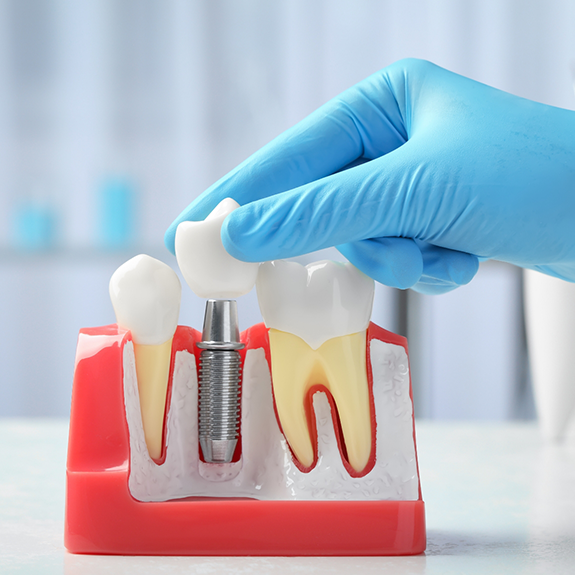
As great as dental implants are, not everyone who might be considering getting them is an ideal candidate. That doesn't mean that implants are completely beyond reach, though. With a special bone grafting procedure, patients who didn’t previously have sufficient bone to support one or more implants may finally qualify for treatment. Once your graft area has healed, we will evaluate when the implant can be placed.
Bone Grafting
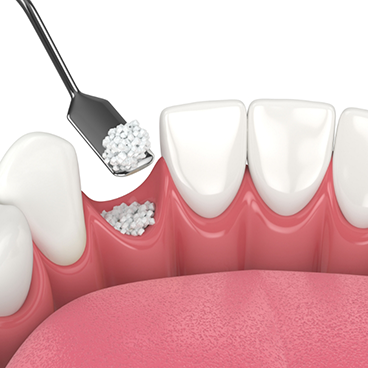
Some patients need bone graft surgery in order to rebuild the shape and size of the alveolar ridge (gum ridge) after tooth loss. If you’ve been missing a tooth for a while, then there has likely been bone resorption. This happens when you don’t have a tooth root to stimulate healthy new bone tissue growth. Bone grafting may absolutely be needed if you’ve lost bone tissue and want to have dental implants to replace your missing teeth.
With the aid of digital X-rays, Dr. Glynn will be able to determine if there is bone loss at the site of a missing tooth. If so, then a small piece of bone from another area of your mouth is harvested and placed on the area of your jawbone that needs to be rebuilt. We can also use freeze dried bone tissue from a human or animal donor. The newly placed tissue will encourage the growth of more bone, thus strengthening the jaw. Once you’ve healed, it will be strong enough to support your new smile.
Dental Implant Failure & Salvage
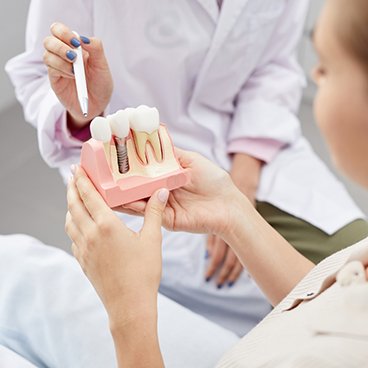
Dental implants are successful in the vast majority of cases – in fact, more than 90% of them are still thriving 10 years after placement. However, there is always a small chance of dental implant failure. If you believe that something isn’t quite right with your restored smile, get in touch with us right away. Dr. Glynn will carefully evaluate your oral health and your implants before designing a treatment plan to resolve the problem.
Dental Implant Technology
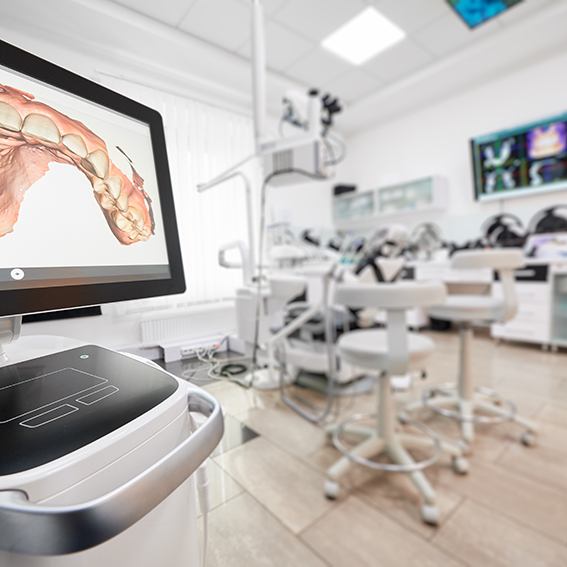
As a highly skilled implant dentist in Reynoldsburg, our team uses our experience and education to provide top-notch care. However, the tools and instruments that we use are also vitally important. They enable us to provide treatment that is as precise and comfortable as possible while minimizing the risk of complications. Would you like to learn more about some of the specific technologies that we use as part of the dental implant process? Continue reading below.
3D Cone Beam Imaging/3D CT Scanning
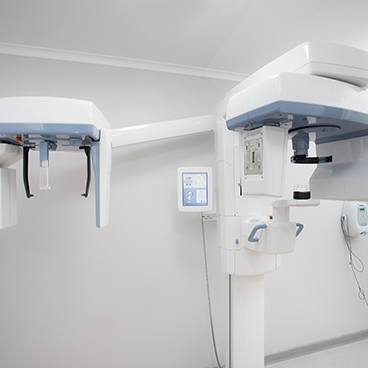
A Cone Beam Computed Tomography (CBCT) machine may also be referred to as a 3D cone beam scanner. This advanced machine is basically a super-powered X-ray. It uses the same type of radiation as regular X-rays, but it is emitted in a cone-shaped beam. It can therefore capture highly detailed, three-dimensional images.
We use our CBCT scanner to get a look at your jawbone, teeth, nerves, and connective tissues. It can help us plan exactly where dental implants should be placed, and it allows us to anticipate unique features of your oral anatomy. We may also take scans after your implants are placed in your jawbone so we can monitor how well they are fusing with the surrounding tissue. If you ever start to experience problems with your implants, the machine can help us to diagnose the cause of your troubles.
The scanning process is quick, non-invasive, and completely painless. Depending on which part of your mouth we are scanning, it might take just a few seconds to capture the images we need! Then, we can view them immediately on our computers and talk to you about our findings.
A CBCT scanner uses more radiation than regular dental X-rays. However, it is still quite safe. And it uses less radiation than a typical CT machine that you would find in most hospitals.
Digital Impression System
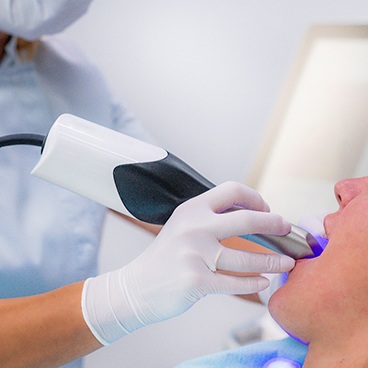
If you have ever had a dental impression taken in the past, you might remember a tedious and uncomfortable process. Thankfully, manual impressions are no longer necessary. Our digital impression system is a remarkable piece of dental implant technology that allows our Reynoldsburg team to easily make a digital, three-dimensional model of your mouth.
All we have to do is move a small wand around your mouth. No manual impression trays or unpleasant putty are necessary! The digital scanner captures thousands of images and then assembles them into a digital representation that we can use to design your new crown, bridge or denture. Once the design is finalized, we simply send it to a laboratory, which will then create your beautiful new teeth.
Digital impressions are extremely accurate. In fact, you can expect your new restoration to fit in seamlessly with your natural bite, which means it should feel very comfortable and lower your risk of issues like broken restorations, a sore jaw, and symptoms of TMJ disorder.
Dental Implants Post-Op Instructions

Your mouth will need some time to heal after you have received dental implants. There’s no need to be nervous; our team will provide you with clear aftercare instructions so that you can keep your discomfort under control and ensure that the recovery process is a success. Below is a quick summary of what you can expect after your dental implants have been placed. Please let us know if there’s anything that you’re unclear on.
What to Do Directly After Dental Implant Surgery

When you head home to rest after your dental implant surgery, your main focus should be on protecting the blood clot at the implant site. Said blood clot plays an important role in the healing process and should not be disturbed. It’s important to be aware of actions that can dislodge the blood clot (such as drinking through a straw, smoking, and touching the implant site) so that you can avoid them for the time being.
Common Side Effects When Recovering from Dental Implant Placement

Minor discomfort, swelling, and intermittent bleeding are all common symptoms that you may experience after receiving your dental implants. They should eventually go away by themselves given enough time, and you can manage them by:
- Taking ibuprofen or other pain-relieving medications.
- Holding a cold compress over any areas where swelling has occurred.
- Using gauze to gently press down on the surgical site whenever it starts to bleed.
Please call us right away if your symptoms seem to be growing worse.
Your Diet After Dental Implant Surgery

You will need to be mindful of what you eat for a while following your dental implant surgery. Before your procedure, you should stock up on soft and liquid foods that you can eat without issue while your mouth is recovering. Some particularly good options include scrambled eggs, mashed potatoes, pasta, and yogurt. You can also have soup, but make sure it’s not too hot.
Post-Op Health & Oral Hygiene
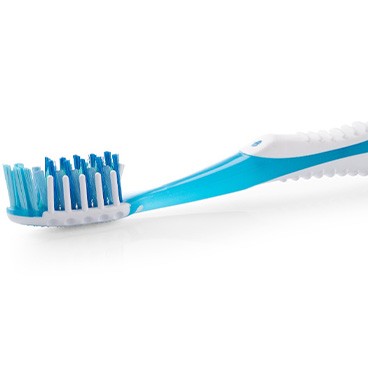
When brushing your teeth after dental implant surgery, remember to exercise great care while cleaning near the area where the implant post was inserted. It’s generally recommended that you get in the habit of rinsing with salt water two or three times a day; this helps reduce the risk of an infection. You might also consider making mouthwash part of your oral hygiene routine. However, you will need to stay away from mouthwash that uses alcohol as an ingredient, as it can slow down the healing process.
What to Do After Your New Teeth Are Attached

Your new teeth will be anchored to your dental implant posts after your mouth has healed from your dental implant surgery. At this point, there shouldn’t be any bleeding or swelling. At most, you may need to take pain relievers in order to deal with sensitive gums. Please let us know right away if you experience unusual symptoms.
Dental Implant FAQs
Why are dental implants better than other tooth replacements?
Tooth replacements such as bridgework, a partial or a full denture rest on top of your gum and only replace the crowns of missing teeth. Because implants replace the roots as well, your jawbone remains healthy. The implants stimulate new bone tissue growth just as natural roots do, which helps you avoid a sunken or sagging facial appearance.
How long is the healing process for a dental implant?
Once oral surgery is complete, the gums will need some time (generally 3 months, but in some cases up to 6 months) to heal. This allows the implant to fuse with the bone tissue. Over time, the foundation for your future restoration will only get stronger.
Can dental implants be used with dentures?
Yes! The denture base is designed to rest on anywhere between four and eight dental implants and not on the gums.
Does dental implant surgery hurt?
Thanks to modern anesthetics, implant surgery goes very well for most of Dr. Glynn’s patients. In fact, most say the procedure is much easier than having a tooth extracted or a cavity filled. You may feel some pressure during the procedure, but otherwise, there should be no discomfort. We will always discuss a type of sedation to assure your comfort during the procedure.
How long do dental implants last?
Dental implants are like teeth in form and longevity. With conscientious oral hygiene at home—brush at least twice a day and floss at least once a day—and regular dental checkups, your dental implants should last a lifetime.
I Need a Checkup & Cleaning I am Worried About Gum Disease I Have a Cavity or Broken Tooth I am Missing One or More Teeth I Want to Enhance My Smile I Want a Straighter Smile I am Scared of the Dentist I Am in Pain & Need Help I Have Jaw Pain I'm Having Trouble Sleeping View Our Services
